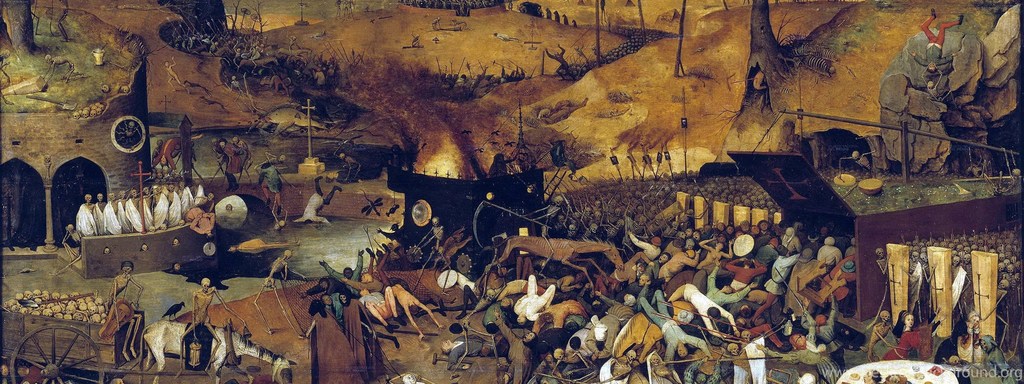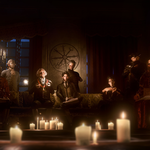The rise of social media has been interesting to watch from an esoteric perspective. It has opened avenues of communication and collaboration that didn’t previously exist; platforms for people to share ideas and creations; and has enabled every kind of sub-group to carve out their own niche and find other like-minded seekers.
But it’s also highlighting new ways people are exploiting the negative side of group dynamics. Going so far, at times, as to harness extremism that can be violent or dangerous to individuals involved. There’s a growing conversation about these issues, so this post looks at some of the warning signs to watch out for with esoteric and occult-focused groups.
These warning signs are, of course, the same for more specialised groups as they are for larger, mainstream religions (or political groups); but it’s worth looking at some examples within a specifically esoteric or occult context. Furthermore, what new issues are starting to arise as we continue integrating our lives more and more into the online space and its open, yet often anonymised communities?
This is a lengthy post about an important topic, so please forgive the long read. For anybody worried whether they might be involved in a dangerous group, it’s a topic worth going into in some detail.
Having said that, this is only a starting point and shouldn’t be considered a comprehensive look at these issues by any means – but I hope it might spark a discussion and framework for all of us to consider the communities we are involved with, whether online or in our lives more generally.
Cults vs. New Religious Movements
A brief disclaimer on the different between cults and new religious. The term ‘cult’ can obviously be applied quite broadly and has different layers of meaning – but in this post we are using it as a negatively framed term that refers to organised groups that utilise practices that are manipulative and/or harmful to individuals involved with them.
In an academic sense, the phrase ‘new religious movements’ is generally more acceptable when talking about a lot of esoteric or occult-focused organisations – as it’s important to enable space for new forms of religion and spirituality to emerge that can be meaningful and beneficial to practitioners. Even though a lot of groups might have strange beliefs and practices, that can seem completely ridiculous to others, that is not reason alone for them to be labelled a ‘cult’.
The boundaries between what makes a New Religious Movement beneficial or negative to its practitioners are not set in stone, they require careful discernment on a case-by-case basis. However, we can use certain criteria to help judge whether the negative elements overwhelm the identity and experience of people participating in them. By looking at the actions of a group as a whole, we can come to a personal decision on whether a specific organisation could be considered a dangerous group or ‘cult’.
10 Warning Signs of Dangerous Groups
The study of dangerous group dynamics has become relatively well codified in recent decades, primarily emerging out of the work of psychologists and sociologists; but also more controversially out of organisations that are helping ‘save’ people from the all-encompassing worldview of organisations they have become involved with.
There’s a lot of nuance to the discussion – and practices such as ‘deprogramming’ can sometimes be as detrimental to the individual as anything else – but when it comes to looking at what are considered the warning signs of groups focused on religion and spirituality, there’s relatively good consensus around the following categories:
- The group is focused on the authority of one person, living or dead;
- There are strict hierarchies in place, with deference to senior members;
- The group fosters an ‘Us vs. Them’ mentality;
- Practices designed to create altered states of consciousness are central;
- Abusive behaviours (whether physical, emotional, or sexual) are justified through teachings;
- Members are cut off from contact with ex-members, including family and friends;
- There is an emphasis on financial gain and/or recruitment for the organisation;
- Behaviours are encouraged that place members in competition with one another;
- Control of information about the group is a primary focus;
- Focus on an ‘end times’, ‘ascension’ or cataclysmic event to come.
Note: this list is my own construction, combining different sources (such as Steve Hassan and Rick Ross) and also wide reading and experiences into what makes a group dangerous as opposed to having deep conviction and spiritual purpose.
Going through that above list with esoteric groups in mind, what might the warning signs look like in practice? Equally, if some of those elements are present is it possible for them to be balanced enough to not be considered detrimental?
This kind of discernment is incredibly situational, so you need to think them through regarding specific examples. A lot of esoteric traditions are inherently strange from an outsider’s perspective, which can sometimes make one doubt your own involvement. However, it’s also important to remember that many of these traditions have existed throughout the ages as important avenues of spiritual fulfilment and inspiration for many of the world’s brightest and most influential people.
Strange though they may seem, there remains a lot of truth and meaning to be found within the mystical and esoteric traditions of the world. Unfortunately, though, the inherently fringe nature of these traditions also makes them ripe for corrupt individuals seeking personal gain and power to the detriment of others.
With all this in mind, let’s look through the warning signs listed above and see what they have to say about the groups we’re most interested in.
1) The group is focused on the authority of one person, living or dead
The concept of masters, gurus and teachers is highly prevalent within esoteric traditions. Indeed, it’s often part of what defines something as esoteric as it needed to be handed down in ways separate from the more exoteric avenues available to mainstream religion. However, dependence on one (or a small number) of individuals for access to truth and wisdom can quickly veer into troubling areas.
In modern groups this is often seen in those who have the loftiest titles (or most extravagant regalia) and regularly manifests in the form of long sermon-like talks or written missives. Some groups do this very overtly – they follow the teachings of one named individual. Others a bit more subtly – the teachings are given as emerging from elsewhere (ancient sources; channelled beings; sacred texts; ascended masters) but interpretation of them is strictly controlled.
When a personality worship emerges that creates an aura of divinity, wisdom, or infallibility around a specific individual it dampens alternative perspectives of the group’s work and teachings. This is usually strongest while such person is alive but can readily continue after their death – as those inheriting the organisation rely on the former leader’s authority to continue controlling members beliefs and behaviours to their own agenda.
Red Flags:
- Teachings of one individual are quoted as scripture and referred to when asking questions;
- Criticism of the group leader/s is punished or chastised;
- Images of the leader are prevalent and/or used as focal points for spiritual practice;
- The leader demands a one-to-one relationship with adherents for them to progress.
Green Flags:
- Discussion of other traditions and/or teachers is encouraged and spoken of positively;
- The leader states they are not infallible or divine, admits their own faults;
- Group activities, teachings and practices are decentralised and open to exploration;
- When an organisation is focused on one individual from the past, it examines both the positive and negative sides of that person and their history.
2) There are strict hierarchies in place, with deference to senior members
Leading on from the first category, which places a supreme leader/s at the top of group hierarchy, is the issue of how strongly the internal hierarchy of the group is maintained and focused upon during normal activities.
This is particularly relevant to esoteric and occult-focused groups, as there are often systems of graded initiation and teachings that build a sense of progress within adherents; while at the same time develop group hierarchies that can have a detrimental effect if not used carefully.
There are good reasons to have grades of initiation, or a gradual introduction to things such as magical or mystical practices, and these can even be put in place for the benefit (and perhaps even protection) of members. The presence of such hierarchies in and of themselves is not necessarily a negative thing, but rather how they are used and whether they become forces of control that stifle alternative perspectives.
Such hierarchies can lead to negative interpersonal issues: whether that’s because they encourage egotistical or patronising behaviour; are used to exclude people who move outside accepted norms; or are designed to generate loyalty and result in excessive amounts of time spent within the organisation to the detriment of other aspects of a person’s life.
Red Flags:
- Members of higher grade or status are considered to have power over others below them;
- Bonding between members of the same rank is discouraged;
- Members of lower grade are not given the opportunity to speak or present their thoughts;
- Grades are given inconsistently and reward loyalty over other traits;
- Decisions made by higher-level members aren’t transparently communicated.
Green Flags:
- There’s clear understanding that grade/rank does not equal spiritual attainment;
- Members of all grades are encouraged to talk and contribute ideas;
- Systems for advancement are codified and consistently given;
- Regular changing of people in roles of authority, ideally through an electoral process.
3) The group fosters an ‘Us vs. Them’ mentality
One of the key elements that makes any group dangerous is when individuals are segregated from wider society. This causes members to lose sense of social norms and how the group might be straying into damaging areas.
Such an approach is often strengthened through harnessing an ‘Us vs. Them’ mentality, in which the outside world (or specific oppressors/enemies) is formulated as inherently aggressive, evil, sinful or stupid because they have not accepted the spiritual truths presented by the group.
In extreme circumstances, this leads to a militant outlook that can promote self-harm among members or violence against outsiders. Even in more benign examples, it is a damaging behaviour that leads to negative personality traits and a general animosity to the world that causes rifts between family, friends and colleagues.
It’s important to also note that it can be expressed through excessive positive emotions, often called ‘love bombing’, in which new members are made to feel like the group is offering them something that can’t be found anywhere else just through the sheer exuberance and amount of affection received. The outside world won’t understand, support or love you as much as the group will.
In occult-based groups the ‘Us vs. Them’ mindset can sometimes be formulated as members having access to spiritual abilities or magical powers not available to others; or that there are evils in the world (e.g. Black Lodges) that the group is in mystical combat with. It can also often be seen through seemingly mundane issues such as being under attack for legal and/or financial reasons.
All of these foster unity among members, as they work together to overcome the outside force working against them. When these forces are framed in terms of cosmic significance, the ability to push people’s behaviour into negative areas becomes increasingly possible and can lead to sudden behavioural changes or poor (even criminal) decision-making.
Red Flags:
- The group speak of themselves as spiritual warriors against an evil force;
- Constant reference to a particular enemy/ideology antagonistic to the beliefs of members;
- Organisational action is inspired by opposition to others;
- Members are asked to put the group above themselves for the ‘greater good’;
- Emphasis is placed on being on the ‘right side’ to fight against oppressors.
Green Flags:
- Group causes are universal and not just applied to members;
- Focused more on developing positive traits in oneself, rather than attacking others;
- The group interacts with a wide range of people, not just their own members.
- There aren’t categories of people/organisations considered impossible to engage with.
4) Practices designed to create altered states of consciousness are central
This is an interesting category, because it is central to basically any group focused on esoteric traditions and occult practices. Mystical and magical practices are specifically designed to induce altered states of consciousness, which means they are universally present (to greater or lesser extent) among these kinds of spiritual groups.
How they are used, then, becomes the important thing to look for. Particularly when such states might enhance the ability for group leaders to control the thoughts and behaviours of members (veering into what is often referred to as ‘brainwashing’).
This can take many forms – including intensive therapy-like sessions, gruelling physical activity and/or dietary restrictions – but within esoteric groups tend to be centred around meditation, yoga, chanting/prayer, initiations and ceremonial magic. It becomes particularly relevant as a warning sign when conducted in a group setting; and even more so when the leader/s of the organisation interpret the experiences for members as they are happening.
Red Flags:
- Practices designed to induce altered states are followed by ideological teachings;
- Interpretation of what is being experienced is placed in terms unique to the group;
- It is stated that such practices give people superhuman powers and/or healing ability;
- These practices are conducted for long periods of time, often to the point of exhaustion.
Green Flags:
- Practices are introduced slowly and carefully, with open discussion about their effect;
- They are seen as explorations with different possible interpretations;
- It is made clear that there’s no ‘one size fits all’ approach to such practices;
- Members are encouraged to discuss such practices without oversight of group leader/s.
5) Abusive behaviours (whether physical, emotional, or sexual) are justified through teachings;
When surrounded by all the trappings of a close-knit group and its ideology, abusive behaviours can be seen as necessary to achieving spiritual goals. The warning sign boils down to a simple concept: abuse is abuse, no matter how it is justified.
Such abuse is often surrounded by negative emotions such as anger, shame, humiliation, lust etc. Occasionally, these things will happen by accident due to the intensity of spiritual practices and also our own flaws as human beings – however, when they are consistent, or even worse, codified by the organisation then it is one of the clearest signs of a dangerous group and should be taken seriously.
In esoteric circles these abusive behaviours tend to revolve around two things: humiliation and sex. Humiliating behaviours are often used to stifle any criticism or free-thinking of members that question the authority of the group and its teachings. These can be verbal attacks, but also often direct punishments such as labour or commands in front of others. They can be forms of emotional abuse, stating that somebody has been possessed by an evil force or is otherwise spiritually flawed.
A whole book could be written on the misuse of sex in occult groups – and indeed it is a common theme among dangerous cults of all kinds. It’s important to know that there is no justification for a sexual teaching to only happen ‘behind closed doors’ and not be presented with an open discussion. Equally, the practice of such teachings doesn’t need to be done in a group setting that crosses personal boundaries or involves peer pressure to participate in activities that in hindsight were more about coercion than spiritual development.
There is no transfer of power or energy from master to student that requires sexual rituals to take place; and when such practices are used in other contexts, they should never occur within abusive power dynamics or as a result of coercion of any kind. Anybody who tells you otherwise is lying; or at best grossly misunderstanding the trust, companionship and unified purpose that such practices require to be used effectively. There are esoteric teachings and practices that revolve around sexuality, but these require a slow acclimatisation and purposeful practice done carefully and always with the deepest respect for all participants acting as equals.
There is never a need for you to be hit, yelled at, humiliated, punished or molested in order to achieve spiritual advancement. Full stop.
Red Flags:
- Members are humiliated in front of others for perceived transgressions;
- General atmosphere of anger and fear exists within meetings and gatherings;
- Teachings are given one-to-one that contain sexual or painful acts;
- Members feel pressured to conduct such acts by others in a group setting;
Green Flags:
- The group has an understanding of compassion for others and their experience;
- Intense activities are conducted carefully and with full explanation beforehand of their process and purpose;
- Leaders of the group actively discourage parasocial and/or emotional connections to form between themselves and members of the group;
- Safeguarding rules are in place to protect the emotional and physical wellbeing of members.
6) Members are cut off from contact with ex-members, including family and friends
One of the clear warning signs of a dangerous group is how they treat people who choose to leave the organisation or change their beliefs. This often combines with an ‘Us vs. Them’ mentality, in which ex-members become persona non grata and there are pressures (whether formalised or not) on members to disconnect from them.
In worst case scenarios, this will include friends and family disconnecting from loved ones merely because they chose to take a different path. Ultimately, this is about control and is often combined with a paranoid worldview fearful of ‘bad influences’ and perspectives that might damage the authority of the group and its leader/s.
Even outside of such drastic examples, there can be more subtle forms such as a high degree of negative gossip and character assassination of past members; or even just a generally passive aggressive attitude towards those who choose to take a different path.
Red Flags:
- Contact with ex-members is not allowed or highly discouraged, whether through formal teachings or peer pressure;
- Ex-members are spoken about in terms that question their character and judgement;
- No discussion allowed of why certain people might have left or their reasons for doing so;
- Purposeful attempts to slander or character assassinate someone to dismiss their criticisms.
Green Flags:
- People are allowed to join and leave freely, without pressured attempts to make them stay or overly criticise them if they choose to leave;
- Criticism of the group is not hidden or dismissed, but rather there are open conversations that allow people to make up their own minds;
- Ex-members remain in contact with people in the group, not for purposes of recruitment but through a genuine care for wellbeing and friendship.
7) There is an emphasis on financial gain and/or recruitment for the organisation
Groups that are truly seeking spiritual development are rarely desperate for new recruits; they also don’t primarily work on monetising members and the public for financial gain. Excessive focus on these things exposes a mindset that sees people as pawns rather than appreciating the full extent of their being and identity.
Emphasis on financial gain can be seen when every communication includes an avenue for the organisation/leader to make money. Common examples include regular fundraising drives; constantly pushing merchandise, workshops or other costly materials; or teaching that giving to the organisation (tithing) is directly linked to one’s spiritual development. In esoteric groups, it can be seen in asking for large fees for initiation or to receive blessings or magical results.
Focus on recruitment is a worrying sign, as it suggests a high churn rate and starts to degrade the relationships between members and the people they meet or know. There’s nothing wrong with wanting to encourage people to take part in your practices or beliefs, but when the focus becomes on converting people then it has clear negative connotations for the group and how it operates.
Red Flags:
- Every communication is coupled with a way to make money, or applauds how many new members have joined;
- Members are encouraged to pay for goods or services in order to advance in the organisation or progress spiritually;
- Recruitment is tasked to lay members that must generate new people to join;
- Value of people is linked to financial contributions and/or ability to bring in new members.
Green Flags:
- Good and services are reasonably priced (even non-profit) and exist in the background;
- Group offers different activities or items for members, accessible for all members to afford without impact on their financial stability;
- No obvious way to tell how much money people have spent; or how many people they might have converted;
- It is made clear that financial contributions and/or ‘spreading the word’ aren’t the primary way to contribute to the group and its wellbeing.
8) Behaviours are encouraged that place members in competition with one another
Groups that deal with both our aspirational and vulnerable sides must do so with an appropriate level of care for individual wellbeing and comfort zones. Dangerous groups can often be seen doing the exact opposite, creating environments where members feel in competition with one another that cause people to behave in ways detrimental to other members.
This can arise from a need to feel validated, particularly when there is one supreme authority handing out gifts of attention or status. Combine this with beliefs of divine purpose and you can quickly create a toxic environment that harnesses resentment, jealousy and anger.
It can often be seen in the way members are played off one another, with favourites being put up on a pedestal while others are degraded in front of the group. Groups that encourage members to report on one another, whether publicly or in private, or otherwise encourage highlighting people’s flaws and shortcomings are another way this can manifest.
Red Flags:
- Leader/s play favourites and give open praise to some members while denigrating others;
- Practices encourage group shaming and/or excessive highlighting of personal shortcomings;
- Members are encouraged to report on one another, whether formally or through gossip;
- It is made clear that only the most loyal followers will rise up the organisational ranks.
Green Flags:
- Practices that encourage introspection or self-analysis are done in a supportive manner;
- It is openly stated that organisational ranks are not necessarily signs of spiritual progress;
- Leader/s do not have clear favourites, but give time to all members as much as possible;
- Interpersonal gossip and criticism are kept to a minimum, particularly within group settings.
9) Control of information about the group is a primary focus
Groups with a destructive core or negative agenda will often be overly paranoid about access to information and public narratives about the group. This can be seen in an overbearing need to control information and/or stop members from engaging with anything that might paint the group in a negative light or talk about problem areas.
At its most extreme, it might take the form of legal action against critics or otherwise harassing them through online or physical campaigns. There are also examples of groups demanding that members install internet filters or are punished for accessing negative sources of information.
In a more subtle way, it can be through peer pressure to not engage with any criticism about the group – or alternatively the encouragement to actively combat it online through comments and social media posts.
Groups confident in themselves and not afraid to face criticism will generally not be concerned about the negative opinions held by others, and certainly not overly worried that members will come into contact with them. They also won’t seek to segregate members in terms of the information they have access to, even if some teachings might be staggered as is often the case in esoteric organisations.
Red Flags:
- Aggressively organising to combat critical information, whether through legal or online campaigns;
- Discussion of critical information is not allowed, even in private conversation;
- The group is subject to a lot of critical information from ex-members, dismissed as being flawed due to the character of such individuals.
- Controls are put in place to limit member access to information, or punishments for access.
Green Flags:
- Not overly worried about secrecy, even if there might be teachings given in stages;
- Members aren’t punished or discouraged from discussing negative information about the group and whether or not it is merited;
- Wide range of feelings (or generally positive) from ex-members discussing their experiences, with negative experiences responded to with a genuine desire to better the organisation.
10) Focus on an ‘end times’, ‘ascension’ or cataclysmic event to come
Perhaps this warning sign is self-evident, but it can be one of the most dangerous so it’s an important one to highlight. Groups focused on eschatological end times or cataclysmic events create environments that are ripe for spiritual, emotional and physical abuse.
This isn’t to say that such teachings are always dangerous, when placed within the right context, but they can be used to foster a sense of emergency that is deeply manipulative and dangerous not just to the individuals involved but also those around them. The worst tragedies of cults – suicide, murder, violence – are almost always combined with an alarmist attitude focused on an imminent end times.
Even if not geared towards impending apocalypse, the notion that members of a group will be the only ones saved or experience ascension into a higher realm can be used to foster unwavering loyalty or used as a deterrent to leaving the group. Positively or negatively framed, these kind of ‘all or nothing’ beliefs are a huge warning sign.
This doesn’t need to manifest in violence in order to be dangerous, either, as it can result in high levels of anxiety or worry about the future; including need to commit everything (such as personal energy and wealth) to the group and the causes put forward by its leader/s.
Red Flags:
- Teachings focused on dangerous end times in the near future, a constant sense of threat;
- Members are told if they leave the group, they will not be ‘saved’;
- Group leaders use alarmism to build loyalty and ask members to sacrifice of themselves;
- People outside the group are seen with suspicion or disdain and will suffer or miss out during the group’s concept of end times.
Green Flags:
- Eschatology is understood in broad terms and approached metaphorically;
- Conceptions of end times are seen in more utopian forms of peace, love and harmony;
- There is no timeframe given or expectation that members will experience it for themselves.
The Patreon Question
A common form of engagement with emerging esoteric groups and occult practitioners today has been the rise of subscription-based online communities, facilitated by platforms such as Patreon or other paywalls.
There is a lot of good that can come out of such models, such as providing a living wage for people creating useful resources for practitioners (or even just entertainment); but unfortunately they also regularly come with strings attached. Not least of which the reality of parasocial relationships and how these paywalled communities can blur social boundaries in a way that makes it difficult for participants to navigate emotionally, sometimes to the detriment of their personal and spiritual development.
On a positive note, they can be accessible to those who might not want to be involved in a specific organisation or are unable to attend in person for whatever reason. On the flipside, however, online communities can also be surprisingly callous. Without the normal social cues and mediating of interpersonal relationships that occur within groups that meet in real life, issues that arise can quickly descend into insults, group bullying and even direct threats.
For communities that are primarily focused on engaging with one another online, many of the warning signs listed above can display themselves to a greater or lesser extent. They all still apply, regardless of whether the group or community in question is virtual, meets only in real life, or is a blend of the two.
Our digital lives provide many avenues for personal and spiritual growth, but they are unfortunately also the new recruiting grounds for individuals and groups that seek to take advantage of people searching for meaning in their lives. It’s important to look at the communities we are involved with in this light – not to be hyper-critical of everything, but so that we can move forward into a journey of faith and spiritual development with confidence and trust.
When it comes to these digital spaces, below are some red flags specific to a subscription-based model that are worth paying close attention to.
Red Flags:
- Subscription tiers are designed to segregate the community and create hierarchy among members, leading to those who feel ‘closer’ to the group leader/s;
- Top tiers provide one-to-one access to the group leader/s in a way that encourages forms of emotional dependence and master/student relationships that feel intimate, but in reality are quite detached from a detailed understanding of individual’s lives;
- Community channels (such as Discord) often erupt into interpersonal issues or forms of ‘shunning’ of individuals deemed outside the group norms (such as excessive banning).
- Group identity is based on a specific person or ‘internet celebrity’ and becomes more of a fan club that encourages parasocial relationships to develop;
- Members are heavily marketed to with products, books, workshops, healing sessions, magical spells, readings etc. and there is a constant focus on money-making activities.
Green Flags:
- There is just one subscription tier for all members; or higher subscription tiers do not provide more access or status within the community;
- Group leader/s refer to community members as equals and with a sense of gratitude rather than service or studentship;
- There are few expectations placed on community members to spend money, volunteer their time or commit to the group in public channels;
- Community moderation is dealt with consistently and there are clear rules and guidelines of behaviour that are applied equally across all members.
Conclusion
I have purposefully tried to keep examples in this article relatively vague and generalised, so that we can all approach organisations we’re involved in from an open perspective. Even if you think that the groups you belong to could never be considered dangerous or damaging, it’s worth going through these categories and considering just how they apply to your own experiences.
Almost every group will involve one, two or perhaps even more of the above elements. That’s not necessarily the issue, but rather as they begin to stack up – and whether they express these things in a positive or negative manner – you can paint a larger picture about the group and what it represents.
Ultimately, most dangerous groups revolve around the accumulation of wealth, power and status for a small number of individuals – perhaps even just one person that posits themselves as a guru, adept or messiah-figure. When you are able to identify that the majority of activities all revolve around those things, you can see the group for what they truly are. Even if not directly harmful to yourself or other members, it’s a sign that they are not there for your benefit but only to enrich themselves in various ways.
The internet provides interesting challenges in these areas. New ideas are hyper-accessible and we can all sometimes become a bit too isolated and narrowly-focused on the communities we find ourselves part of. The notion of parasocial relationships is important to understand; where people running the group are seen as friends and trusted guides, but we might not have a sense of who they really are (or even, in some instances, what they look like!) and the relationships are one-sided and exploitative.
Finally, the above is just an overview of potential warning signs and is by no means a complete list. Every case is unique, and your own circumstances won’t necessarily perfect fit the ideas in this article. The key thing is that you should always feel able and supported in raising questions, thoughts and even criticisms of anything you are involved with.
The moment such a thing is no longer possible, or you feel pressured into doing things for ‘your own good’, is when you should stop and take note of your surroundings to see if you are where you really need to be. By doing so, you might discover that the people around you don’t necessarily have your best interests at heart.









